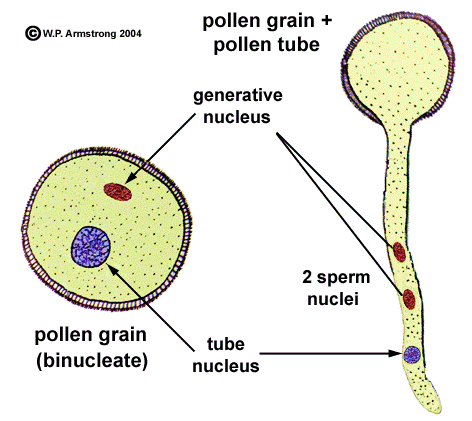Answer
384k+ views
Hint:-The part of the male gamete—the sperm cell—during the time spent preparing is to perceive, stick to, and intertwine with the female gamete. These exceptionally specific capacities are relied upon to be constrained by the initiation of a novel arrangement of qualities.
Complete Answer:-A binucleate angiosperm dust grain containing a generative core and a cylinder core. After the dust grain develops into a dust tube, the generative core isolates into two sperm cores. Since the generative core and sperm cores contain cytoplasmic sheaths, they are regularly alluded to as cells in certain course books. The cylinder core controls the development of the dust tube as it becomes down the style and into the ovary of a blossom. In the end, it infiltrates the micropyle of an ovule and deliveries its two sperm into the 8-nucleate undeveloped organism sac. During twofold preparation, one sperm wires with the egg core to frame a zygote. The other sperm wires with the two polar cores inside the endosperm mother cell to shape the endosperm. In corn, this cycle must happen for each grain that structures. Much additionally astounding is the development of discrete dust tubes down each strand of silk (styles).

Note:- The dust grain has two cores called the cylinder core and the generative core. After the cycle of fertilization, a dust tube is developed by dust grains that travel through the disgrace and style and arrive at the ovules in the ovary and afterward the generative core partitions to frame two male gametes in which one wire with egg and other with polar cores.
Complete Answer:-A binucleate angiosperm dust grain containing a generative core and a cylinder core. After the dust grain develops into a dust tube, the generative core isolates into two sperm cores. Since the generative core and sperm cores contain cytoplasmic sheaths, they are regularly alluded to as cells in certain course books. The cylinder core controls the development of the dust tube as it becomes down the style and into the ovary of a blossom. In the end, it infiltrates the micropyle of an ovule and deliveries its two sperm into the 8-nucleate undeveloped organism sac. During twofold preparation, one sperm wires with the egg core to frame a zygote. The other sperm wires with the two polar cores inside the endosperm mother cell to shape the endosperm. In corn, this cycle must happen for each grain that structures. Much additionally astounding is the development of discrete dust tubes down each strand of silk (styles).

Note:- The dust grain has two cores called the cylinder core and the generative core. After the cycle of fertilization, a dust tube is developed by dust grains that travel through the disgrace and style and arrive at the ovules in the ovary and afterward the generative core partitions to frame two male gametes in which one wire with egg and other with polar cores.
Recently Updated Pages
Basicity of sulphurous acid and sulphuric acid are

What is the stopping potential when the metal with class 12 physics JEE_Main

The momentum of a photon is 2 times 10 16gm cmsec Its class 12 physics JEE_Main

Using the following information to help you answer class 12 chemistry CBSE

Which of the following would not be a valid reason class 11 biology CBSE

Why should electric field lines never cross each other class 12 physics CBSE

Trending doubts
Difference Between Plant Cell and Animal Cell

Difference between Prokaryotic cell and Eukaryotic class 11 biology CBSE

Fill the blanks with the suitable prepositions 1 The class 9 english CBSE

Change the following sentences into negative and interrogative class 10 english CBSE

Give 10 examples for herbs , shrubs , climbers , creepers

Fill the blanks with proper collective nouns 1 A of class 10 english CBSE

Select the word that is correctly spelled a Twelveth class 10 english CBSE

How fast is 60 miles per hour in kilometres per ho class 10 maths CBSE

What organs are located on the left side of your body class 11 biology CBSE



